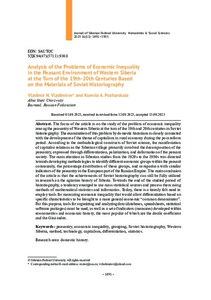Анализ проблем экономического неравенства в крестьянской среде Западной Сибири рубежа XIX–XX вв. по материалам советской историографии
Автор:
Владимиров, В. Н.
Пожарская, К. А.
Vladimirov, Vladimir N.
Pozharskaia, Kseniia A.
Дата:
2023-11Журнал:
Журнал Сибирского федерального университета. Гуманитарные науки. Journal of Siberian Federal University. Humanities & Social Sciences; 2023 16 (11)Аннотация:
В центре внимания статьи находится изучение в советской историографии
проблемы экономического неравенства крестьянства Западной Сибири на рубеже
XIX–XX вв. Рассмотрение отечественными историками этой проблемы тесно связано
с разработкой темы развития капитализма в сельском хозяйстве пореформенного
периода. Проявлением развития капиталистических отношений в сибирской деревне,
согласно методологическим построениям советской науки, выступало прежде
всего разложение крестьянства, проявлявшееся в дифференциации, поляризации
и деформации крестьянского социума. Основной вектор внимания в сибиреведении
1920–1980-х гг. был направлен на разработку методик выявления разноуровневых
экономических групп внутри крестьянской общности, процентного соотношения
этих групп и сравнения с аналогичными показателями крестьянства европейской
части Российской империи.
Основной вывод статьи заключается в том, что достижения советской историографии
до сих пор могут быть полноценно использованы в исследованиях по аграрной
истории Сибири. В конце изучаемого периода историографии была заложена
тенденция использования массовых статистических источников и их обработки
методами математической статистики и информатики. На сегодняшний день
остро ощущается необходимость использования таких инструментов измерения
экономического неравенства, которые позволили бы привести дифференциацию
по отдельным признакам к более общему экономическому «знаменателю». Для
этого должны использоваться средства организации и анализа данных (базы
данных, электронные таблицы, статистические пакеты), а также набор показателей
(измерителей), выработанных в рамках эконометрики и экономической истории,
наиболее популярными из которых являются децильный коэффициент и индекс Джини The focus of the article is on the study of the problem of economic inequality among the peasantry of Western Siberia at the turn of the 19th and 20th centuries in Soviet historiography. The examination of this problem by domestic historians is closely connected with the development of the theme of capitalism in rural economy during the post-reform period. According to the methodological constructs of Soviet science, the manifestation of capitalist relations in the Siberian village primarily involved the decomposition of the peasantry, expressed through differentiation, polarization, and deformation of the peasant society. The main attention in Siberian studies from the 1920s to the 1980s was directed towards developing methodologies to identify different economic groups within the peasant community, the percentage distribution of these groups, and comparison with similar indicators of the peasantry in the European part of the Russian Empire. The main conclusion of the article is that the achievements of Soviet historiography can still be fully utilized in research on the agrarian history of Siberia. Towards the end of the studied period of historiography, a tendency emerged to use mass statistical sources and process them using methods of mathematical statistics and informatics. Today, there is a keenly felt need to employ tools for measuring economic inequality that would allow differentiation based on specific characteristics to be brought to a more general economic “common denominator”. For this purpose, tools for organizing and analyzing data (databases, spreadsheets, statistical software packages) must be used, as well as a set of indicators (measures) developed within econometrics and economic history, the most popular of which are the decile coefficient and the Gini index

